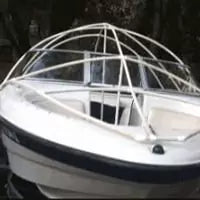How to make a boat cover support system

Building a Boat Cover Support System: A Step-by-Step Guide

Why You Need a Boat Cover Support System
Your boat is more than just a watercraft—it's an investment and a source of joy and relaxation. Naturally, you want to protect it from any potential harm. While a boat cover is an essential component of safeguarding your vessel, it alone may not be sufficient, particularly in regions with inclement weather conditions such as heavy rainfall or snowfall.
When precipitation accumulates on a boat cover, it can create significant problems. The weight of the water can cause the cover to sag and create pools or pockets where water can seep through. This pooling effect not only puts stress on the cover but also increases the risk of damage to your boat's interior. Excessive moisture can lead to mold, mildew, and corrosion, resulting in costly repairs or even permanent damage.
This is where a boat cover support system proves invaluable. By providing additional support and preventing water from pooling, this system acts as a proactive defense against potential damage to your boat and its cover. The support system works by elevating the cover and creating a framework that effectively sheds water off its surface. This prevents water from accumulating and allows it to easily slide off, keeping your boat and its cover dry and protected.

A well-designed boat cover support system extends the lifespan of your boat cover. By evenly distributing the weight of the cover, it minimizes stress on the material and prevents sagging. This helps maintain the cover's shape and integrity, ensuring its durability over time. Additionally, the support system promotes proper airflow, preventing moisture from getting trapped and allowing your boat to breathe.
Beyond protecting your boat's exterior, a boat cover support system also safeguards the interior components. With the support system in place, you can avoid issues such as water seepage, mold growth, and electrical damage caused by excessive moisture. By effectively shedding water away from the cover, the support system helps maintain a dry and clean environment for your boat, preserving its value and minimizing the need for repairs.
Investing in a boat cover support system is a proactive measure that demonstrates your commitment to the long-term care of your boat. It ensures that your vessel remains in optimal condition, ready for your next adventure on the water. With the added peace of mind that comes from knowing your boat is protected from the elements, you can fully enjoy your time on board, whether you're cruising along the coast or docking at your favorite marina.
Choosing the Right Boat Cover Support System
Before you start building your boat cover support system, it's crucial to select the right components. Here are some key considerations:
Material and Durability
Opt for materials that are sturdy and weather-resistant. Aluminum or fiberglass poles are popular choices due to their strength and ability to withstand harsh conditions. Ensure that the connectors and fittings are made of corrosion-resistant materials like stainless steel or UV-treated plastic to prevent deterioration over time.
Adjustability and Ease of Installation
Look for a support system that offers adjustability, allowing you to customize the height and tension according to your boat's size and the cover's material. Additionally, opt for a system that is easy to install and dismantle, ensuring hassle-free usage and storage.
Weight and Portability
Consider the weight and portability of the support system, especially if you plan to transport your boat frequently. Lightweight and collapsible systems are convenient to carry and store, making them a practical choice for boat owners on the go.

Step-by-Step Guide to Building a Boat Cover Support System
Measure for boat cover support system
Now that you have the necessary information to choose the right support system, let's dive into the step-by-step process of building one:Step 1: Measure and Assess
Start by measuring the length and width of your boat. Assess the shape and height of your boat's frame to determine the appropriate support structure.Step 2: Gather the Materials
Collect all the materials required for building the support system. This typically includes aluminum or fiberglass poles, connectors, fittings, straps, and any additional hardware specified by the manufacturer.Step 3: Attach the Poles
Attach the poles to the boat's frame, ensuring a secure and stable connection. Use adjustable fittings to accommodate different heights and ensure a snug fit.Step 4: Secure the Cover
Place the boat cover over the frame and ensure it's centered and evenly spread. Secure the cover to the support system using straps or clips provided by the manufacturer.Step 5: Adjust and Tension
Adjust the height and tension of the support system to prevent water from pooling on the cover. Ensure that the cover remains taut but not excessively tight, allowing for proper airflow.Step 6: Test and Fine-Tune
Test the support system by applying pressure on various points. Make any necessary adjustments to ensure the cover is adequately supported and water drains properly.
Maintaining and Extending the Lifespan of Your Boat Cover Support System
To make the most of your boat cover support system and ensure its longevity, follow these maintenance tips:

Regular Cleaning boat cover support system
Clean the support system regularly, removing any dirt, debris, or salt residue. Use a mild detergent and a soft brush to avoid scratching the poles or connectors. Rinse thoroughly with water and allow it to dry completely before storing.
Inspect for Damage
Inspect the support system for any signs of wear and tear, such as bent or damaged poles, loose fittings, or frayed straps. Replace or repair any damaged components promptly to maintain the system's effectiveness.
Proper Storage
Store the support system in a dry and well-ventilated area to prevent rust and corrosion. Disassemble and fold the system neatly, ensuring that all parts are securely stored. Avoid placing heavy objects on top of the components to prevent bending or warping.
Seasonal Adjustment
Make seasonal adjustments to the support system as necessary. For instance, in areas with heavy snowfall, raise the height of the support system to prevent the accumulation of snow on the cover, which could lead to excess weight and potential damage.By following these guidelines and constructing a reliable boat cover support system, you can enjoy peace of mind knowing that your boat is well-protected from the elements. Regular maintenance and care will ensure that your support system lasts for years, providing the necessary support for your boat cover and preserving the condition of your cherished vessel.
0 comments


